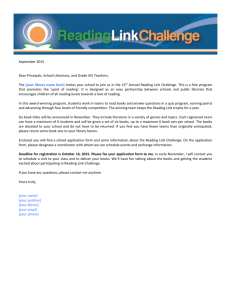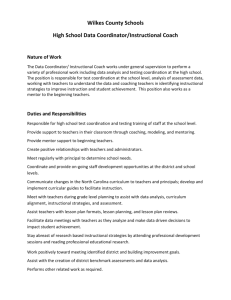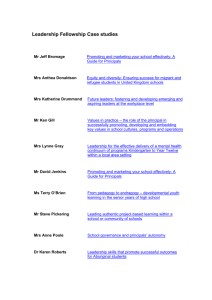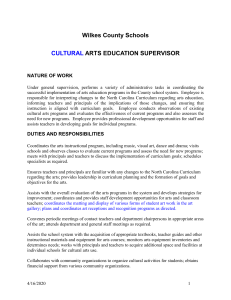Section One: The Principals Role
advertisement
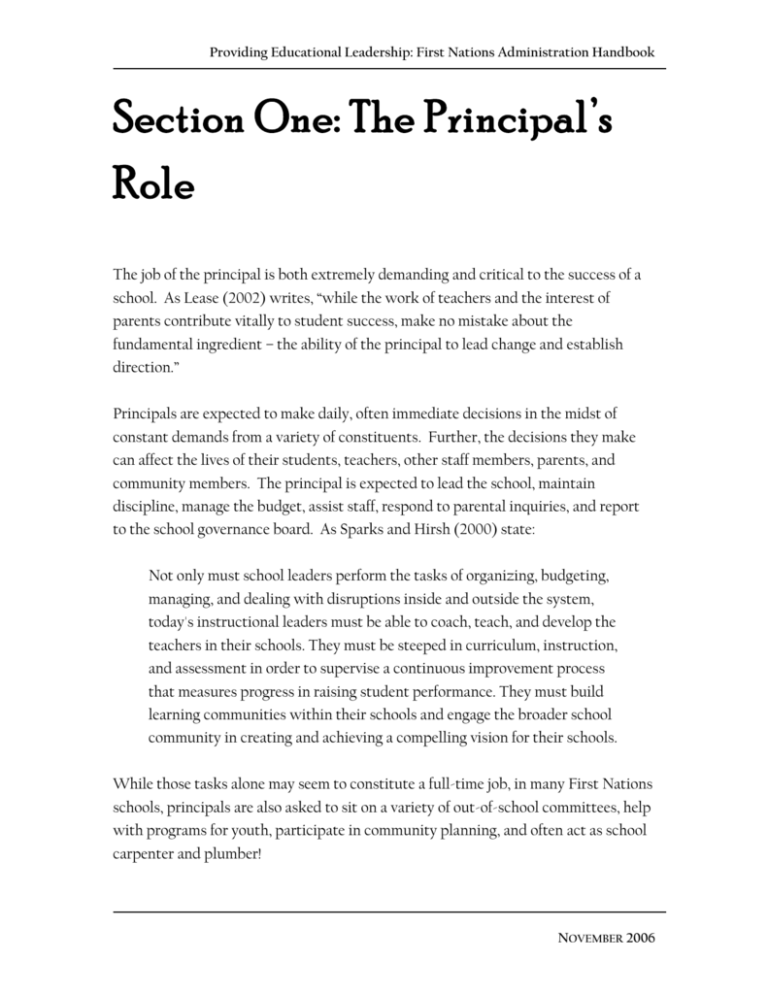
Providing Educational Leadership: First Nations Administration Handbook Section One: The Principal’s Role The job of the principal is both extremely demanding and critical to the success of a school. As Lease (2002) writes, “while the work of teachers and the interest of parents contribute vitally to student success, make no mistake about the fundamental ingredient – the ability of the principal to lead change and establish direction.” Principals are expected to make daily, often immediate decisions in the midst of constant demands from a variety of constituents. Further, the decisions they make can affect the lives of their students, teachers, other staff members, parents, and community members. The principal is expected to lead the school, maintain discipline, manage the budget, assist staff, respond to parental inquiries, and report to the school governance board. As Sparks and Hirsh (2000) state: Not only must school leaders perform the tasks of organizing, budgeting, managing, and dealing with disruptions inside and outside the system, today's instructional leaders must be able to coach, teach, and develop the teachers in their schools. They must be steeped in curriculum, instruction, and assessment in order to supervise a continuous improvement process that measures progress in raising student performance. They must build learning communities within their schools and engage the broader school community in creating and achieving a compelling vision for their schools. While those tasks alone may seem to constitute a full-time job, in many First Nations schools, principals are also asked to sit on a variety of out-of-school committees, help with programs for youth, participate in community planning, and often act as school carpenter and plumber! NOVEMBER 2006 Providing Educational Leadership: First Nations Administration Handbook In some ways, the various roles of school principals can be divided into management and leadership responsibilities, although there is of course considerable overlap between the two categories. Managers focus on "running a smooth ship," while Although the role of the principal as instructional leader is widely instructional leaders focus on learning and advocated, it is seldom practiced; instruction. Effective principals are both principals still spend most of their managers and instructional leaders, time dealing with managerial issues. recognizing that both roles are essential and providing a balance between management and instructional skills (Chell, 2002). Often, management responsibilities can, if allowed, take up all of a principal’s time, particularly because management issues are often very pressing and require immediate action. The consensus in the literature is that, although the role of the principal as instructional leader is widely advocated, it is seldom practiced; principals still spend most of their time dealing with managerial issues. Stronge (1988, cited in Chell, 2002) calculated that elementary school principals spent 62.2% of their time on managerial issues and 11% on instructional leadership issues, even after undergoing training or in-service emphasizing their role as instructional leader. Thus, the image of instructional leadership has become entrenched in the professional rhetoric but all too often is lacking in administrative practice. Similarly, the FNSA annually collects data from First Nations schools to explore their staffs, programming, and educational results. The 2005 data collection initiative asked schools to indicate how their administrators’ FTE is allocated by estimating the percentage of total work time that is assigned to a list of tasks. The results of that question are shown below (FNSA, 2006). Allocation of administrator’s time Day-to-day administration Financial administration Instructional leadership Classroom teaching Out-of-school meetings Other Average % time per task 39% 16% 18% 11% 9% 7% NOVEMBER 2006 Providing Educational Leadership: First Nations Administration Handbook Total 100% To be truly effective, principals must pay adequate attention to both their management and leadership functions. Some of the management and leadership responsibilities of a principal are outlined below, and more detail about many of the key activities is provided in further sections of this handbook. The participants at the FNSA sponsored workshops described the balance between management and leadership functions in terms of a pie chart. Principals are continually pushing to enlarge the time allocated to leadership functions – a continual battle given the plethora of other pressures they face. The workshop participants encouraged one another to keep pushing the boundaries to find more time for their leadership roles. How a Principal's Time is Spent 9% 7% 39% 11% 18% 16% Day-to-day administration Financial administration Instructional leadership Classroom teaching Out-of-school meetings Other NOVEMBER 2006 Providing Educational Leadership: First Nations Administration Handbook 1.1 A Principal’s Management Responsibilities Most people are fairly familiar with the numerous management responsibilities of principals. Principals are concerned with the overall functioning of the school, including ensuring that it is operational for the commencement of each school term and having a full school staff in place. Principals also manage the school budget and ensure that the funding available will allow the school to operate for the duration of the school year. Principals are responsible for having reasonable timetables in place. In addition, principals are generally asked to oversee discipline, ensure school safety, organize regular staff meetings, and maintain the school’s record keeping, busing system, and instructional supplies. Many of those issues will be discussed further in section four: managing day-to-day operations. That section includes a review of topics such as file keeping, school calendar, policy development, staff meetings, school budget and resources, school safety, drug and alcohol awareness, scheduling, and technology. Appendix Two of this document includes many sample school policies that relate to a range of administrative issues. Principals should feel free to adapt the samples to make them appropriate for their particular situations and needs. 1.2 A Principal’s Leadership Responsibilities As mentioned above, while a principal’s management function can often seem to constitute a full-time job, it is imperative that principal’s maintain a focus on their role in “educational leadership” – that is supervision, ensuring quality curriculum and instruction, and ensuring that the school is continually working towards its goals for improvement. According to Robbins and Alvy (1995), “leadership practices of principals in high-performing schools include helping to establish clear goals, providing a vision of the good school, and encouraging teachers by assisting them in finding the necessary resources to carry out their jobs.” NOVEMBER 2006 Providing Educational Leadership: First Nations Administration Handbook While the leadership practices of principals are certainly central for all schools, they have special relevance for First Nations schools, which are more autonomous and usually not part of a broader educational decision-making structure, such as a school While the leadership practices of principals are central for all schools, district. That means that the principals of most they have special relevance for First First Nations schools are often responsible for Nations schools, which are leadership and decision-making functions that particularly autonomous. are otherwise undertaken by District personnel. It also means that principals of First Nations schools are more isolated in their decisionmaking, a fact that brings many unique challenges and opportunities. Principals are, primarily, the instructional leaders of their school, meaning that they shape the environment in which teachers and students succeed or fail. Although teachers are absolutely critical to the learning that takes place at the classroom level, the principal addresses school-wide issues in instruction and curriculum that relate to classroom decisions, and as such they have a significant impact on all of the teaching that takes place in the school. Principals, therefore, must understand every facet of instruction at a high level (Lease, 2002). As the instructional leader, the principal can affect every factor that encourages student learning in the school, and the principal is also responsible for continually assessing the school’s operations and programs to ensure that they are meeting community and school expectations. One of the key components of instructional leadership, then, is knowing what the community and school expects for its students, and maintaining a clear focus on the goals or the “vision” for the school. Some schools may not have a clearly stated philosophy or a defined vision of what the school can achieve. In those instances, the principal can help the school and community to identify their educational values and set out a vision. If a vision has already been developed, the principal can ensure that it is shared, understood, and that people commit to the vision so that it remains a real guide for the school’s programs and activities. In this regard, principals act as planners and prioritizers for their schools, sorting through the massive range of possible NOVEMBER 2006 Providing Educational Leadership: First Nations Administration Handbook approaches and programs and maintaining a focus on what matters for their students and community. More information about creating and maintaining a school vision is included in section two of this handbook. Principals are also the shapers of the school culture, which can become either a positive influence or a significant barrier to learning. The elements that make up a school’s culture include all aspects of the school’s environment that have the potential to influence the learning, discipline, and morale of all those who work and study there. According to Pasi (2001), the ongoing challenge for principals is to identify steps for enhancing school culture and the conditions under which students can learn more, educators can teach more, and everyone can feel welcome and respected. Therefore, one of their critical roles of principals is that of “morale builder.” Ideally, principals will create a school culture that celebrates growth and high achievement. As Ramsey (1992) notes, “everyone in the school community should know full well Fundamentally, teachers must feel that the principal is an unequivocal advocate comfortable and safe at the school, for excellence and that anything less is regardless of what is taking place unacceptable.” Principals also need to create elsewhere. a school culture in which teachers feel supported, and principals must make every effort to ensure that teachers are successful. Fundamentally, teachers must feel confident and safe at the school. It is imperative that, regardless of what is taking place in the wider community, the school culture must remain positive and clearly aimed at making the school a better place for students. The issues of creating a positive school culture and working with teachers are discussed more in sections two and three of this handbook. NOVEMBER 2006 Providing Educational Leadership: First Nations Administration Handbook 1.3 Liaison With the Community For all schools, but particularly for First Nations schools, another primary role of the principal is to maintain strong and positive connections with the community. First Nations schools operate completely within the context of their communities, and effective principals understand and make the most of that context. As mentioned above, it is the role of the principal to protect, as much as possible, students and staff from anything negative that may be going on outside of the school, and to maximize the benefits of positive and encouraging community developments. At the same time, principals are primarily responsible for ensuring beneficial public relations for the school, sharing the good things that are happening and fostering a respectful, constructive relationship with Chief and Council, the school governing authority, and the community at-large. The important connection of the school and community will be discussed in more detail in many of the following sections of this handbook. NOVEMBER 2006 Providing Educational Leadership: First Nations Administration Handbook 1.4 Other Duties Anyone familiar with the role of a principal in a First Nations school recognizes that there are numerous other duties associated with that position. Anyone phoning for the principal will often be told that he or she is busy at the moment, fixing the school roof, or helping to clear snow from the school playground, or helping the cooperative education leader drive students to their work placement, or helping to build a community garden. The demands on a First Nations school principal can seem endless. Because of that reality, it is critical that principals realize the importance of practicing good time management, ensuring ongoing self-development, and making every effort to maintain their own health and well-being. Those issues are discussed more in section five of this handbook. NOVEMBER 2006 Providing Educational Leadership: First Nations Administration Handbook The Canadian Association of Principals Statement on Education Leadership The Essential Tasks of School-Based Leadership The purpose of this statement is to describe the qualities or capacities that school-based administrators need to provide educational leadership in the school setting. Strategic Leadership Facilitate the development of a shared vision of learning and the purposes of the school. Create conditions in the school and community to achieve that vision. Resolve problems in achieving the school’s vision. Manage a planned change process and action plan to improve the school and learning. Understand and critically examine educational, social, and economic issues. Understand the major historical, philosophical, ethical, and economic influences on schooling and learning. Manifest a personal code of ethics or values. Assessment and Evaluation Conduct assessments of the needs and achievements of students and staff. Use data and surveys to monitor progress. Engage school staff in the study of best practices. Analyze and present findings about trends, issues, and applications of educational strategies to school staff, parents, and the community. Instructional Leadership Develop the school’s learning culture. Create a school culture supportive of learning and development. Base decisions on research, applied theory, informed practice, and recommendations from experts. Adapt curricula and develop programs to meet the needs of students. Help staff members to align their use of teaching strategies with instructional goals and recognized effective teaching practices. Supervise the staff of the school based on shared agreements of purposes and criteria for success. Make use of a variety of staffing patterns and student groupings. Ensure regular assessments of student progress and communications of results. Professional Development and Human Resources Identify the professional development needs of all members of the school staff. Use adult learning strategies in the professional development including authentic problem solving, mentoring, and opportunities to practice. Analyze the job requirements and work processes of the school. Encourage all staff to establish selfdevelopment plans and offer incentives such as recruitment, induction, and compensation. NOVEMBER 2006 Providing Educational Leadership: First Nations Administration Handbook Student Services Ensure that the school’s student services include guidance, counseling, and academic/vocational services. Facilitate and ensure effective communications with social, health, and training agencies. Encourage staff, parents, and other organizations to organize extra-curricular activities. Management and Supervision Ensure effective management and administrative practices within the school to maximize efficiencies. Develop and assign staff roles and establish criteria for effectiveness. Interpersonal Relationships Communicate well and often with different audiences within the school. Financial Management Review financial and other resources to identify savings and potential sources of funding. Assess the current use of technology in the business operations of the school. Establish and monitor a long-term technology plan for the school. Make extensive use of technology to assist adult learners to stay or return to school. Integrate the introduction of technology with the School’s Improvement Plan. Community and Media Relations Secure the support of the community and influential leaders for your school goals, plans, and progress. Describe the school’s goals, plans, and programs effectively to parents, community leaders, business groups, colleges, universities, research institutions, and others. Link the school to local community learning services such as libraries, museums, science centers, agencies, and professionals. Facilitate parent access through open houses, workshops, newsletters, and information meetings. For more information, see www.cdnprincipals.org Establish a long-term plan for the acquisition and updating of equipment and facilities. Make financial information accessible to staff and parents. Information Systems and Technology Use technology to enrich curriculum and instruction. NOVEMBER 2006


